Putin’s annexation plans primarily targeting domestic audience, encouraging conscription, but likely to fail, says ISW
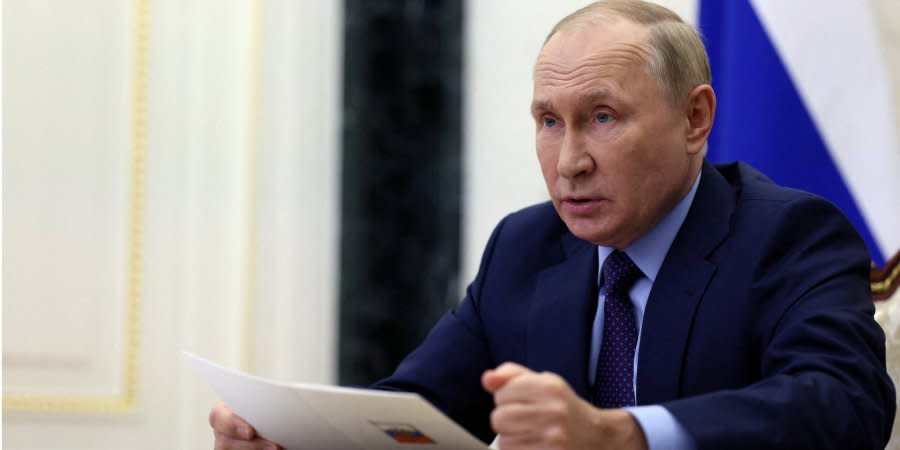
- Oops!Something went wrong.Please try again later.
The measures, announced simultaneously with increasing punishment for desertion in the Russian army, and Russian dictator Vladimir Putin’s desire to push for “self-mobilization” in Russia, are political mistakes by the Kremlin, ISW said.
According to ISW, Putin likely hopes to improve Russian force generation capabilities by calling on the Russian people to volunteer for a war to “defend” newly claimed Russian territory.
Read also: Russian dictator Putin announces partial mobilization, threatens to use nukes
Putin likely hopes that increasing self-mobilization, and cracking down already serving but wavering Russian forces, will enable him to take the rest of Donetsk and defend Russian-occupied parts of Luhansk, Kherson, and Zaporizhzhya oblasts.
“He is mistaken,” ISW experts said.
“Putin has neither the time nor the resources needed to generate effective combat power.
But Putin will likely wait to see if these efforts are successful before either escalating further or blaming his loss on a scapegoat.”
Experts believe his most likely scapegoat is Defense Minister Sergei Shoigu and the Russian Ministry of Defense. Reports that Shoigu would accompany Putin while Putin gave a speech announced and then postponed on Sept. 20 suggest that Putin intended to make Shoigu the face of the current effort.
“Putin and his advisors have apparently realized that current Russian forces are insufficient to conquer Ukraine and that efforts to build large forces quickly through voluntary mobilization are culminating short of the Russian military’s force requirements,” the report says.
Putin is therefore likely setting legal and informational conditions to improve Russian force generation without resorting to expanded conscription by changing the balance of carrots and sticks the Kremlin has been using to spur voluntary recruitment, ISW experts believe.
For this, Putin is adding new and harsher punishments in an effort to contain the risk of the collapse of Russian military units fighting in Ukraine and draft-dodging within Russia.
The Kremlin rushed the passage of a new law through the State Duma, the Kremlin’s rubberstamp parliament, on Sept. 20, circumventing normal parliamentary procedures.
Read also: State Duma member calls for full mobilization in Russia
This law codifies dramatically increased penalties for desertion, refusing conscription orders, and insubordination. It also criminalizes voluntary surrender and makes surrender a crime punishable by 10 years in prison. The law notably does not order full-scale mobilization or broader conscription or make any preparations for such activities.
At the same time, Putin may believe that he can appeal to Russian ethnonationalism and the defense of purportedly “Russian peoples” and claimed Russian land to generate additional volunteer forces.
ISW has observed no evidence that the Kremlin is imminently intending to change its conscription practices. The Kremlin’s new law is about strengthening the Kremlin’s coercive volunteerism, or what Chechen leader Ramzan Kadyrov called “self-mobilization.”
Read also: What Russia and Putin's power are built on – NV interview with UK writer Peter Pomerantsev
Here are additional arguments from ISW analysts in support of these theses:
Putin’s illegal annexation of occupied Ukrainian territory will broaden the domestic legal definition of “Russian” territory under Russian law, enabling the Russian military to legally and openly deploy conscripts already in the Russian military to fight in eastern and southern Ukraine. Russian leadership has already deployed undertrained conscripts to Ukraine in direct violation of Russian law and faced domestic backlash. Russia’s semi-annual conscription cycle usually generates around 130,000 conscripts twice per year. The next cycle runs from Oct. 1 to Dec. 31.
Annexation could provide him a legal loophole allowing for the overt deployment of conscripts to fight.
Russian-appointed occupation officials in Kherson and Zaporizhzhya oblasts announced the formation of “volunteer” units to fight with the Russian military against Ukraine. Russian forces will likely coerce or physically force at least some Ukrainian men in occupied areas to fight in these units, as they have done in the territories of the Russian proxy “Donetsk and Luhansk People’s Republics” (“DPR” and “LPR”).
The Russian State Duma separately passed new incentives for foreign nationals to fight in Russia’s military to obtain Russian citizenship and will likely increase overseas recruitment accordingly. That new law, which deputies also rushed through normal procedures on Sept. 20, allows foreign nationals to gain Russian citizenship by signing a contract and serving in the Russian military for one year. Russian law previously required three years of service to apply for citizenship.
Putin’s appeals to nationalism may generate small increases in volunteer recruitment from within Russia and parts of occupied Donetsk and Luhansk.
However, forces generated from such volunteers, if they manifest, will be small and poorly trained. Most eager and able-bodied Russian men and Ukrainian collaborators have likely already volunteered in one of the earlier recruitment phases.
Read also: Macron calls for limit to UN Security Council veto right due to Russian aggression
According to ISW analysts, Putin likely also intends to deter Ukraine’s ongoing counteroffensives by annexing occupied Ukrainian territory and framing Ukrainian attempts to liberate occupied territory as attacks on Russia. Russian officials and propagandists such as Russian Security Council Deputy Chairman Dmitry Medvedev issued vague warnings on Sept. 20 that “the infringement of Russian territory is a crime; committing this crime permits using all means of self-defense.” Russian officials are demonstrably panicked over Ukrainian advances, as ISW assessed on Sept. 19.
“The Kremlin likely intends these vague warnings to exacerbate Ukrainian and global fears of nuclear escalation,” the report says.
“However, Putin has already declined to enforce any territory-specific redlines in response to Ukrainian attacks on Russian-annexed Crimea, occupied territory he has controlled for eight years and declares to be Russian.”
Other key takeaways from the report:
Ukrainian forces continued disrupting ongoing Russian efforts to re-establish ground lines of communications (GLOCs) across the Dnipro River in Kherson Oblast.
Read also: Russia has lost the war
Russian forces are likely targeting Ukrainian dam infrastructure in Kharkiv and Luhansk oblasts to threaten Ukrainian positions along the Siverskyi Donets River.
Russian forces conducted ground attacks in Donetsk Oblast on Sept. 20.
Russian forces continue to degrade their force generation capabilities bycannibalizing training elements to fight in combat formations in Ukraine.
Map of combat operations
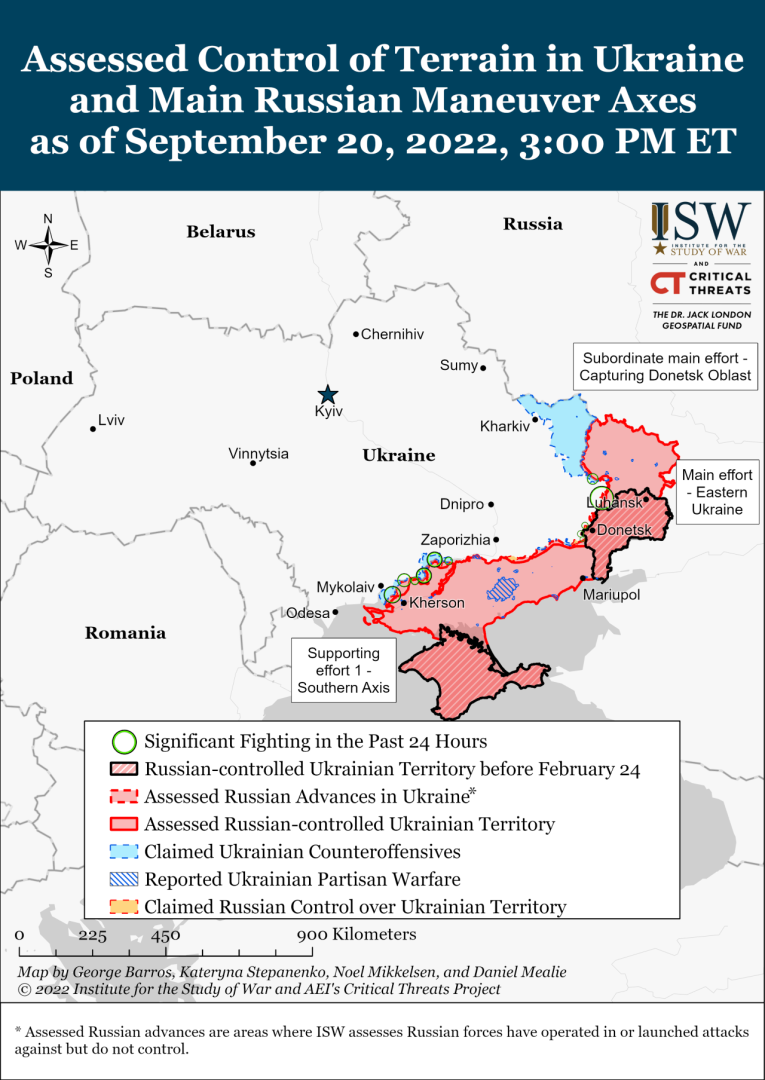
Battles in Donbas: map
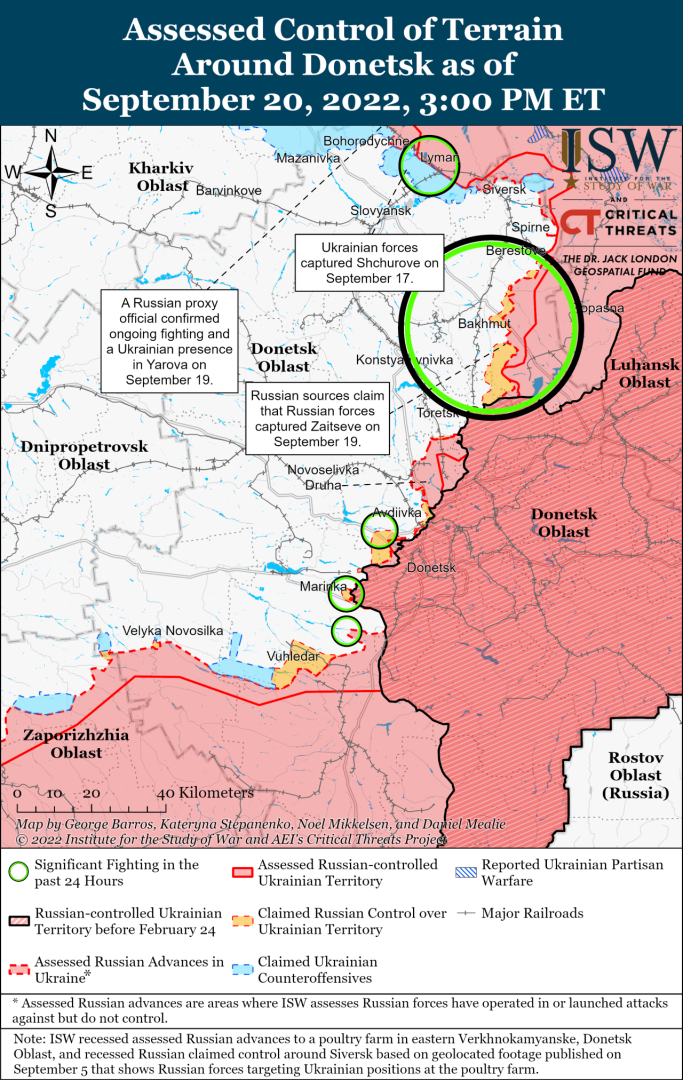
Battles and offensive of the Armed Forces of Ukraine in the Kharkiv Oblast: map of combat operations
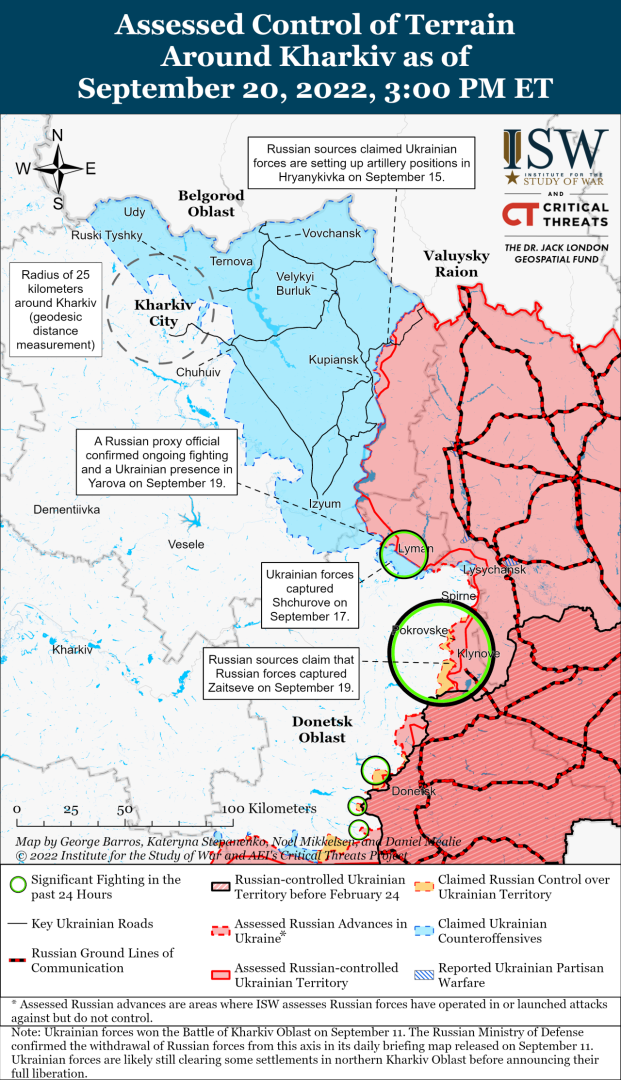
Battles and offensive of the Armed Forces of Ukraine in the south of Ukraine: map of combat operations (Kherson Oblast)
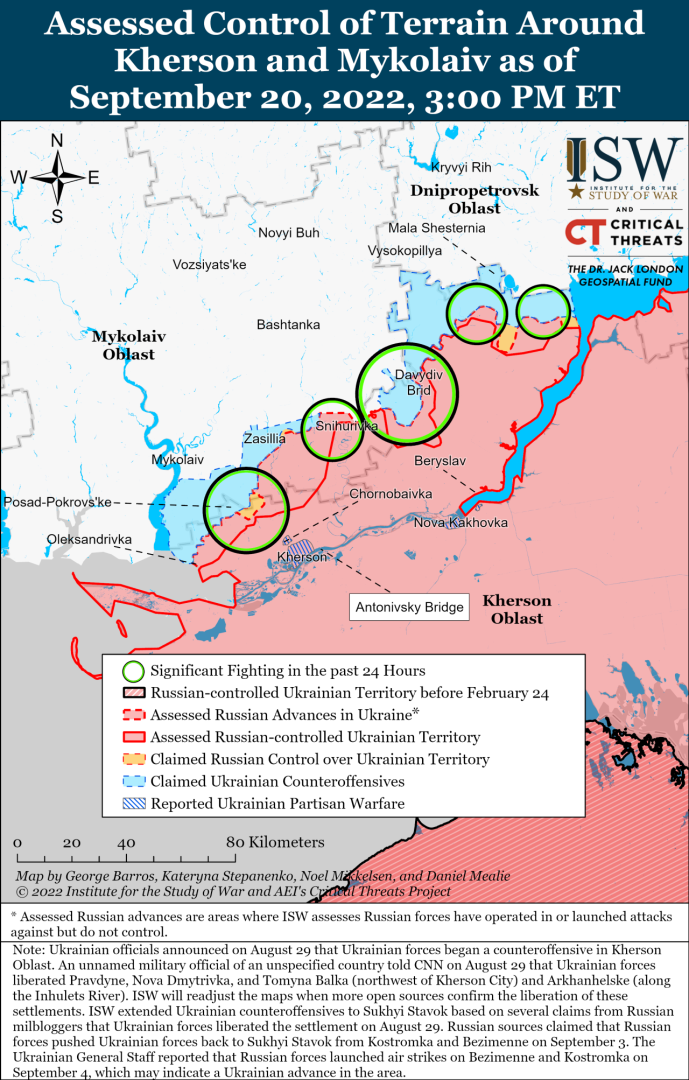
Read the original article on The New Voice of Ukraine

